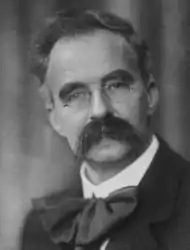Louis Bolk
Lodewijk 'Louis' Bolk (10 December 1866, Overschie – 17 June 1930, Amsterdam) was a Dutch anatomist who created the fetalization theory about the human body.[1] It states that when a human being is born, it is still a fetus, as can be seen by its (proportionally) big head, lack of coordination, and helplessness. Furthermore, this "prematuration" is specifically human.

Gavin de Beer and Stephen Jay Gould wrote about him and further developed this theory of neoteny in humans.[2]
Also Jacques Lacan took Bolk's fetalization theory into account in order to introduce his own thesis on the mirror stage.
Bolk wrote in Origin of Racial Characteristics[3] in Man, “White skin...started from an ancestor with a black skin, in whose offspring hair and iris color were suppressed more and more.”

References
- Verhulst, J. (1993). "Louis Bolk revisited II—Retardation, hypermorphosis and body proportions of humans". Medical Hypotheses. 41 (2): 100–114. doi:10.1016/0306-9877(93)90054-T. PMID 8231987.
- Gould, S. J. (1977). Ontogeny and Phylogeny. Cambridge, Massachusetts: Belknap Press. Chapter 10: Retardation and Neoteny in Human Evolution. The Fetalization Theory of Louis Bolk, pages 356–362. ISBN 978-0-674-63940-9.)
- Bolk, L. (1929). "Origin of racial characteristics in man". American Journal of Physical Anthropology. 13 (1): 1–28. doi:10.1002/ajpa.1330130123. ISSN 1096-8644.